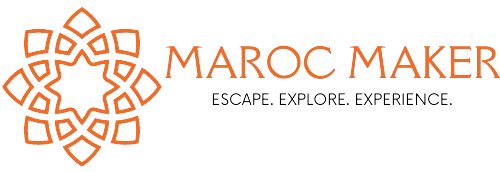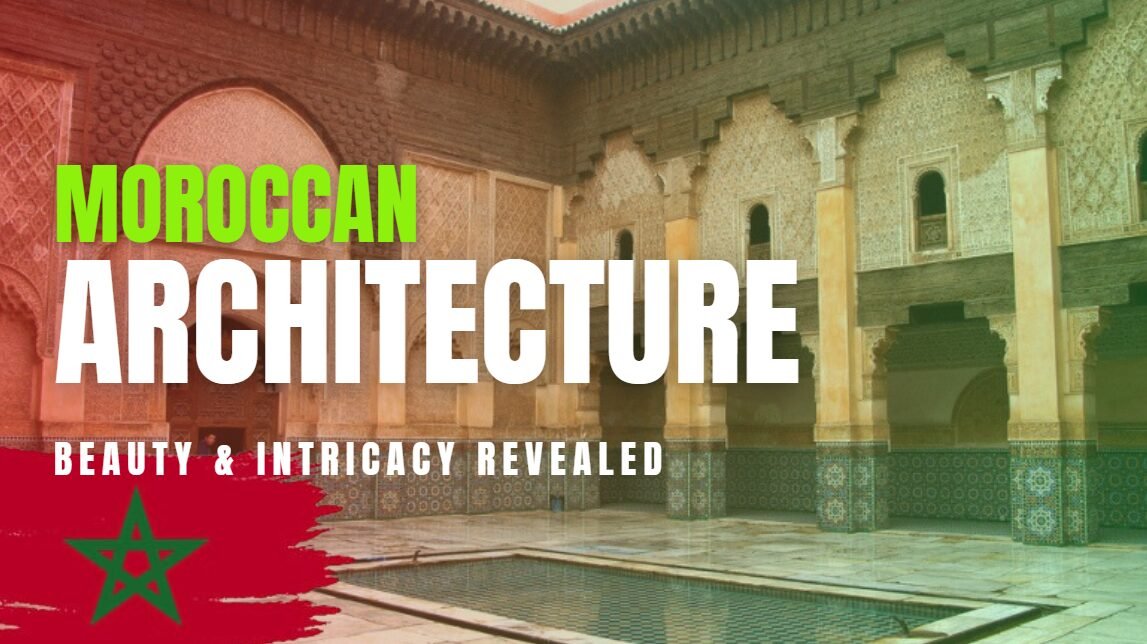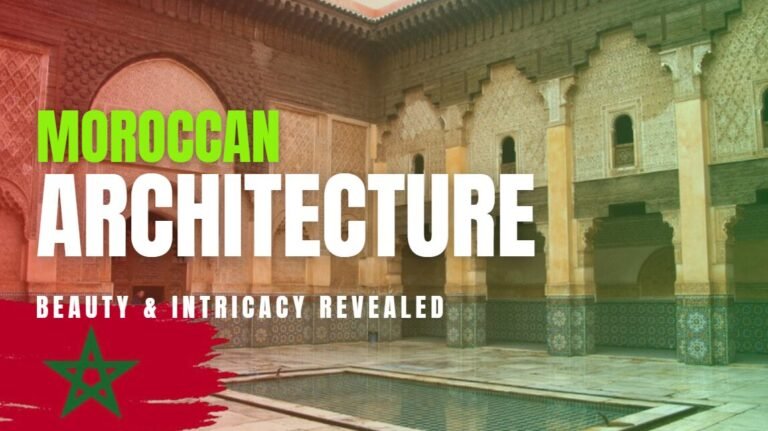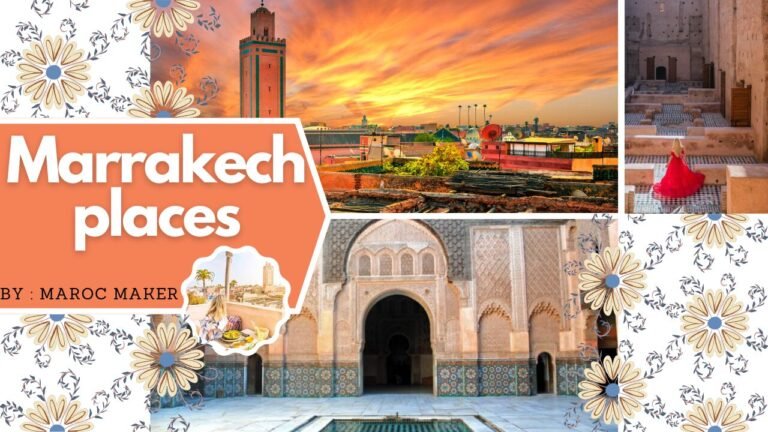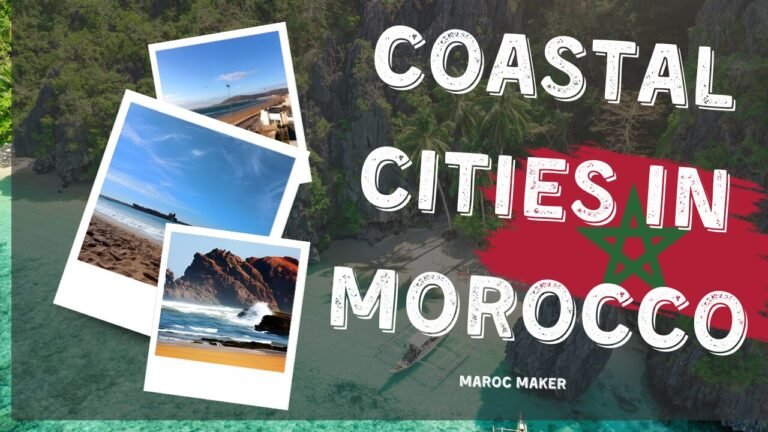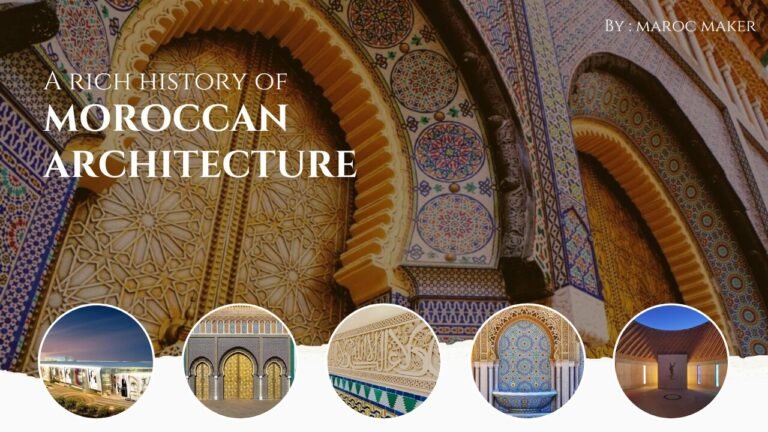Ready to discover the unique charm of Moroccan buildings? Moroccan architecture combines dazzling beauty with meticulous detail. It shows off Morocco’s deep cultural heritage in a striking way. In this piece, we’ll delve into where it came from, what it’s made of, its styles, and how it’s built. We’ll also look at how it shapes today’s design world and the part it plays in Moroccan life. Come along and uncover the mesmerizing appeal of Moroccan architecture.
Key Takeaways:
- Moroccan architecture showcases intricate beauty and cultural significance.
- Moorish architecture has heavily influenced Moroccan architectural styles.
- Geometric patterns, intricate tilework, arches, and courtyards are key elements of Moroccan architecture.
- Riads, medinas, kasbahs, and mosques are unique architectural styles in Morocco.
- Traditional construction techniques like adobe brick, plasterwork, and wood carving are employed in Moroccan architecture.
Origins of Moroccan Architecture
Moroccan buildings showcase a charming mix of impacts that have carved its special identity over time. One big impact on Moroccan design is from Moorish architecture. The Moors brought this during medieval times. The combination of Moorish design features with local Moroccan skill has led to the breathtaking architectural styles we witness now.
Moroccan architecture’s past is shaped by Islamic experiences from the 7th and 8th centuries. Islam adoption in North Africa introduced a fresh architectural style. It sparked off complex geometric shapes, swirling designs, and artistic writing. These components established Moroccan architecture. They crafted a visual dialogue mixing both spiritual values and artistic appeal.
Moroccan architecture matured, absorbing aspects of many cultures over time. It took colors from Berber, Arab, Jewish, and Andalusian traditions. You can see this broad blend of cultural conversations in the different building designs you find throughout the nation.
Influences of Moorish Architecture
The Moorish style, first seen in Spain’s Andalusia, hugely influenced Moroccan building designs. The Moors were Muslims from North Africa and Arab lineage, and they introduced an advanced building style. This style was marked by detailed work, stunning arches, and ornamental tiles.
The Alhambra, located in Granada, Spain, stands out as a signature Moorish-style building in Morocco. The stunning castle and walled fortress astonish with detailed plaster masterpieces, patterned motifs, and resourceful green landscaping. These elements highlight how Moroccan architecture has been shaped by Moorish artistry.
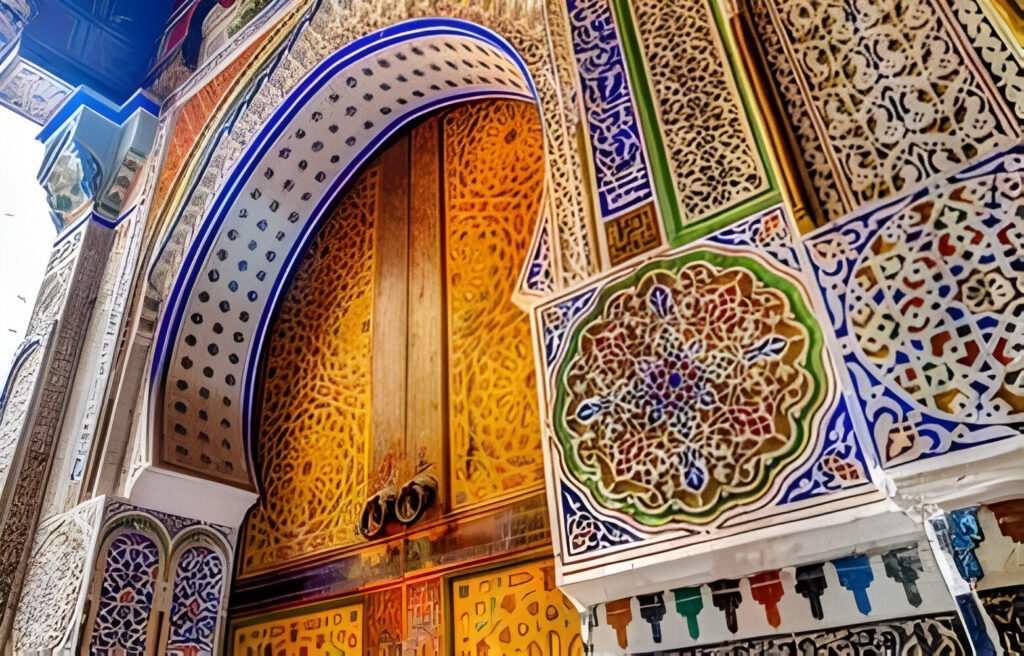
Unique Characteristics of Moroccan Craftsmanship
Moroccan craftwork is famous for its keen precision and superb skills. Craftsmen use age-old methods handed down over the years to build architectural gems showcasing the country’s deep-rooted cultural legacy.
Let’s talk about Moroccan art. It has a special thing called Zellige. This is a type of pattern design made from tiles. You can find it on walls, floors, even ceilings. Making Zellige is a careful process. Every tile is put in place by hand. It creates a beautiful explosion of color that is complex, yet pleasing to the eye.
Arches are a key feature in Moroccan structures. They appear in doors, windows, and paths. They add beauty and balance. The horseshoe arch is common in Moroccan design. It’s a signature detail of Moorish architecture.
Moroccan architecture shines with skilled craftsmanship. Each building detail shows art, vividly reflecting the country’s cultural past and artistic wealth.
In the next section, we will explore the key elements of Moroccan architecture and their cultural significance.
Elements of Moroccan Architecture
Moroccan buildings are known for amazing features demonstrating a mix of skilled work and cultural meaning. These features, based in age-old customs, offer a delightful sight and mirror the deep roots of Morocco’s tradition.
Moroccan architecture stands out for its geometric shapes. You can see these shapes all over, on walls, ceilings, even floors. Many use zellij tilework to show these detailed designs. This way of creating is very important in Moroccan craft. It shows how carefully they pay attention and the accuracy of their math skills.
Arches are a signature feature in Moroccan design. They take various forms like the horseshoe, pointed, or the well-known Moorish arch. Their smooth bends bring beauty and flow to the buildings. More than just a fundamental aid, arches also represent togetherness and knowledge in Moroccan tradition.
Peaceful courtyards are a key part of Moroccan buildings, offering calm spots in busy cities. These spots are designed with green plants, detailed wood screens, and stunning fountains. This makes a balance between nature and building design.
Moroccan artisans are really skilled and dedicated. They make fine things, continuing old craft methods. The beauty and realness of Moroccan designs is kept alive this way, passing down through generations.
Moroccan architecture elements are more than just pretty. They have deep meanings linked to culture, religion, and society. These elements tell a story. They show the Moroccan peoples’ history and beliefs. It’s like a woven tapestry that ties the past and the present together.

Types of Moroccan Architecture
The buildings of Morocco are profoundly diverse, reflecting the nation’s vivid cultural tapestry and artisan skills. Let’s voyage through a few notable Moroccan architectural styles that have enchanted tourists and residents equally.
Riads
Riads, Moroccan homes, have a courtyard in the middle. They often have beautiful gardens and detailed fountains. The buildings are known for their detailed tiles, crafted wood roofs, and private feel. These peaceful spots are found in busy cities. They show the fancy side of Moroccan life.
Medinas
Medinas, part of Moroccan city history, are famous for their maze-like alleys, lively markets, and detailed design. These areas, packed with folks, usually have tall gates, terrific palaces, and impressive mosques. Serving as both cultural and business centers, Medinas hold onto old customs but welcome new trends.
Kasbahs
Kasbahs, once guardian forts or palaces for Moroccan folks, stand as testaments to the past. With their robust walls, tactically set towers, and detailed artwork, they highlight the area’s protective architecture. These grand constructions recall the glory of bygone eras, providing a peek into Morocco’s plentiful past.
Mosques
Morocco has many fantastic mosques, showing the deep faith here. These holy places have tall minarets, detailed tiles, and big prayer rooms. Some beautiful ones are the Hassan II Mosque in Casablanca and the Koutoubia Mosque in Marrakech. They show the amazing Moorish style found across the country.
Here’s a snapshot of the range of architectural styles in Morocco that together influence the nation’s identity and culture. Each type offers a distinct allure, winning over visitors with its careful minutiae and enduring elegance.

Traditional Construction Techniques
Moroccan architecture stands out due to its use of time-honored building methods. These ways, like making adobe bricks, plasterwork, and wood carving, hold a key part in keeping Moroccan architecture’s genuine feel and cultural legacy alive.
Adobe Brick Construction
Adobe brick making is an age-old technique. It’s all about creating bricks from a mix of mud, clay, and straw. These bricks are then sun-dried before use. This method has been around for centuries and is popular in classic Moroccan architecture. The big plus? Adobe bricks are awesome insulators. They help keep spaces cool in summer and cozy when winter comes around.
Plasterwork
Look at Moroccan buildings, and you’ll find detailed plasterwork everywhere. This isn’t just decoration, plaster work does two things. First, these beautiful patterns brighten up the place, and second, they keep the building dry and stable. This artwork covering walls, ceilings, and outside surfaces is created by experts who know their stuff. Using gypsum, lime, and sand, they craft amazing designs like complex shapes, flowers, and even exquisite calligraphy.
Wood Carving
Wood carving is pretty big in Moroccan craftsmanship. Talented folks carve detailed designs onto doors, windows frames, and ceilings. You’ll find shapes, arabesques, and even nature stuff in the carvings. These carvings not only make Moroccan buildings look awesome, but also show the crafters’ skill and eye for detail.
It’s really important to keep those old building methods going. Doing this helps Moroccan architecture stay alive and keeps its cultural importance. By using these methods in new designs, architects and designers can show respect for the country’s long history. At the same time, they can make spaces that bring together the old and the new.
Influences on Modern Moroccan Architecture
Today’s Moroccan buildings show a change. They mix age-old skills with fresh designs to make a new kind of look. Lots of things have had an effect on the way these buildings now look in Morocco. The balance they’ve managed to find shows the bid to keep old traditions alive with the push for cutting-edge ideas.
Contemporary Design Trends
Modern Moroccan architecture has a major influence: it’s where new design trends meet. Think minimalism, sustainability, and functionalism. Now, mix these with classic Moroccan styles. What you get is a perfect merging of past and present. It’s how Moroccan architecture keeps up with what society needs today.
Global Integration
Modern Moroccan architecture is changing due to global influences. Ideas and styles from all over the world are playing a large part in this change. International architecture brings new views, supplies, and designs to Moroccan creators. This connection to the world adds richness and variety to Moroccan craftsmanship and opens doors for teamwork between cultures.
Preserving Moroccan Craftsmanship
Even though current trends have an impact, Moroccan craft skills are still vital in today’s Moroccan architecture. Architects keep up with time-honored arts and methods from the past. The complex tiling, fancy sculpting, and design patterns, all distinctive for Moroccan craft are part of today’s structures. This keeps Moroccan architecture real and loaded with cultural value.
Embracing Innovative Approaches
Moroccan architecture is staying relevant and progressing, thanks to the creative methods architects are adopting. They’re weaving in fresh technology, green materials, and principles for saving energy into their works. The fusion of age-old skill and present-day invention is revolutionizing possibilities in architectural design.
Traditional skills and contemporary trends strike a balance in Moroccan design. This allows it to adapt and remain significant in our fast-paced world. It stands as proof of the flexibility and everlasting charm of Moroccan building customs.

The Role of Moroccan Architecture in Society
Supporting the feel of Moroccan communities, the local architecture does a key job. It builds a unity feeling and strengthens the nation’s tourism and money aspects. The Moroccan building styles mix Moorish designs and homegrown arts. This blend woos people worldwide, immersing them in Morocco’s rich cultural mixture.
Moroccan Architecture: A Cultural Tapestry
Moroccan architecture is built around intense, detailed artistry that’s passed down for ages. You’ll find this in the geometric designs on zellij tiles and even the calming noise of water in beautiful courtyards. Each part isn’t just design; it’s an echo of Morocco’s deep-rooted artistic history.
Busy markets intertwine with calm Moroccan homes, shaping society’s core. They mirror Moroccan values and customs, forming unique places that breed unity. Morocco’s amazing structures are common meeting spots. Here, loved ones unite, celebrate, and bask in the appealing scenery.
Moroccan Architecture and Tourism
Moroccan building styles are a big hit with tourists who drop by the nation. The complex patterns, calming color schemes, and peaceful vibes move visitors. Every feature, from the mosque arches to the tall minarets, stirs a feeling of amazement and curiosity.
Moroccan architecture isn’t just pretty. It gives people a way to learn about the local culture and traditions. It’s easy to get lost in the winding medinas, buy handmade rugs, pottery, or leather things, or even live in a classic riad. All this makes the Moroccan architecture visit a complete experience.
Moroccan Architecture and the Economy
Moroccan architecture does more than add cultural and tourism value. It also boosts the economy. The upkeep and repair of antique buildings and precious structures offer jobs for craftsmen, artisans, and architects.
Morocco, popular with tourists, is known for its skilled artisans. As more visitors discover this country, the appeal of traditional Moroccan crafts soars. Many admire their carved wood designs, handcrafted tiles, and intricate metalwork. The international demand for these pieces aids Morocco’s economy and bolsters its exports.
Morocco’s stunning architecture has fueled a bustling hotel scene. Riads and boutique hotels mix old-world charm with today’s conveniences. These spots are big hits with travelers, offering unforgettable stays.
In conclusion, Moroccan architecture not only showcases the incredible talent of Moroccan artisans and the influence of Moorish architecture but also serves as a symbol of cultural identity. It invites visitors to explore the rich heritage of Morocco, fostering a deeper understanding and appreciation for the country’s artistry, craftsmanship, and sense of community.
Preservation Efforts and Challenges
In order to safeguard the cultural heritage of Moroccan architecture, various efforts are being made to preserve historical buildings and the traditional craftsmanship that accompanies them. However, these preservation initiatives are not without their challenges. Let’s explore the commendable endeavors being undertaken and the obstacles faced in maintaining the integrity of Moroccan architecture.
Preservation Initiatives
The preservation of Moroccan architecture involves a multi-faceted approach that combines restoration, conservation, and education. Government bodies, non-profit organizations, and individuals play crucial roles in these preservation efforts. They collaborate to protect historical landmarks, promote sustainable restoration practices, and raise awareness about the value and significance of Moroccan craftsmanship.
One prominent organization contributing to the preservation of Moroccan architecture is the Moroccan Heritage Foundation. Established in 2000, the foundation focuses on the conservation of historic buildings, including palaces, mosques, and medinas. Through research, restoration projects, and educational programs, they strive to ensure the continuation of Morocco’s architectural legacy.
Additionally, there are ongoing efforts to document and record traditional construction techniques and artisanal skills. Through partnerships with craftsmen, researchers, and cultural institutions, valuable knowledge is documented, preserved, and passed down to future generations. These initiatives aim to safeguard the unique skills involved in Moroccan craft, such as intricate tilework, plasterwork, and wood carving.
Challenges Faced
Preserving Moroccan architecture presents several challenges that require careful consideration and innovative solutions. One significant challenge is the rapid urbanization and modernization occurring in Moroccan cities. The growth of the urban landscape often leads to the demolition or modification of historic buildings, making it imperative to strike a balance between development and preservation.
Another challenge lies in the restoration process itself. Historical buildings require meticulous attention to detail, high-quality materials, and skilled craftsmanship. However, finding trained artisans who possess the necessary expertise can be challenging. There is a risk of losing specific traditional techniques if preservation practices are not supported and passed on effectively.
Financial constraints are also a hurdle in the preservation domain. Restoration projects can be expensive, and acquiring funding can be a perpetual challenge. The high costs involved in maintaining buildings, conducting research, and training skilled artisans require sustainable funding models and support from both the public and private sectors.
Lastly, the effects of climate change and natural disasters pose additional threats to the preservation of Moroccan architecture. Rising temperatures, erosion, and extreme weather events can negatively impact historical structures, necessitating proactive measures to mitigate these risks and protect the architectural heritage of Morocco.
Collaborative Solutions
Addressing these challenges requires a collaborative approach involving multiple stakeholders. Governments, local communities, architectural professionals, and academia must work together to develop comprehensive preservation strategies, implement effective policies, and allocate resources for restoration and conservation projects.
Education and awareness campaigns are vital in promoting the value of Moroccan architecture and encouraging sustainable practices. By fostering an appreciation for heritage and craftsmanship, future generations can be inspired to become custodians of this exceptional architectural tradition.
“Preserving the cultural heritage of Moroccan architecture is a collective responsibility, demanding collaboration, innovation, and unwavering dedication.”- Moroccan Heritage Foundation
Contemporary Innovations in Moroccan Architecture
In recent years, Moroccan architecture has witnessed a wave of contemporary innovations that seamlessly blend traditional techniques with modern design concepts. Architects and designers are pushing the boundaries of creativity while staying true to the essence of Moroccan craft and culture.
One notable area of innovation is the integration of sustainable practices into Moroccan architecture. Aware of the importance of environmental conservation, architects are incorporating eco-friendly materials and energy-efficient technologies into their designs. This not only reduces the carbon footprint but also preserves Morocco’s natural resources for future generations.
Another trend is the incorporation of cutting-edge technology in Moroccan architecture. Advanced construction techniques and materials are being utilized to create buildings that boast both functional efficiency and aesthetic appeal. Smart home systems, solar panels, and efficient insulation are just a few examples of how technology is transforming the architectural landscape in Morocco.
Furthermore, contemporary Moroccan architecture champions minimalist design, which highlights the elegance of clean lines and open spaces. This departure from the ornate complexity of traditional Moroccan architecture creates a fresh and modern aesthetic, attracting a new generation of architectural enthusiasts.
Moreover, the integration of traditional Moroccan crafts in modern designs is gaining popularity. The intricate tilework, delicate wood carving, and stunning geometric patterns that define Moroccan craftsmanship are being incorporated into contemporary buildings, creating a harmonious blend of old and new.
To showcase the impact of these contemporary innovations, here are a few notable examples of modern Moroccan architecture:
| Building Name | Architect | Location |
|---|---|---|
| Villa E | Studio Ko | Marrakech |
| Yves Saint Laurent Museum | Studio KO | Marrakech |
| La Grande Mosquée | Miralles Tagliabue EMBT | Casablanca |
| Bank al-Maghrib Headquarters | Foster + Partners | Rabat |
| Hotel Sahrai | Christophe Pillet | Fez |
These architectural marvels showcase the fusion of traditional Moroccan craftsmanship with contemporary design elements, creating spaces that are both visually captivating and functionally innovative.
Contemporary innovations in Moroccan architecture demonstrate the adaptability and fluidity of this ancient artform. By embracing modern technologies, sustainable practices, and minimalist design, architects are reinventing Moroccan architecture, ensuring its enduring relevance in the ever-evolving architectural landscape.
Conclusion
This piece delves into the stunning world of Moroccan architecture. It highlights the remarkable aspects like beautiful shapes, attractive tiles, and unique archways. This type of architecture reflects the deep heritage of Morocco. Its mix of age-old skill and fantastic design has won global attention, proving itself as a long-lasting and ageless art.
Moroccan architecture plays a vital role in preserving Morocco’s artistic heritage. It reflects the country’s history, traditions, and cultural identity. The craftsmanship involved in creating these architectural wonders, from the skilled artisans to the mastery of techniques, has been passed down through generations, ensuring the preservation of Moroccan craft.
The influences of Moorish architecture, combined with the unique elements of Moroccan design, have shaped a distinctive architectural style that continues to inspire architects and designers worldwide. The beauty of Moroccan architecture can be witnessed in riads, medinas, kasbahs, and mosques, each with its own charm and significance.
As we conclude this exploration of Moroccan architecture, we are reminded of its lasting impact and its ability to transport us to a world of beauty and intricacy. This architectural treasure has not only shaped the physical landscape of Morocco but has also contributed to its culture, society, and tourism. Moroccan architecture stands as a testament to human creativity and the power of design to tell stories and preserve history.
